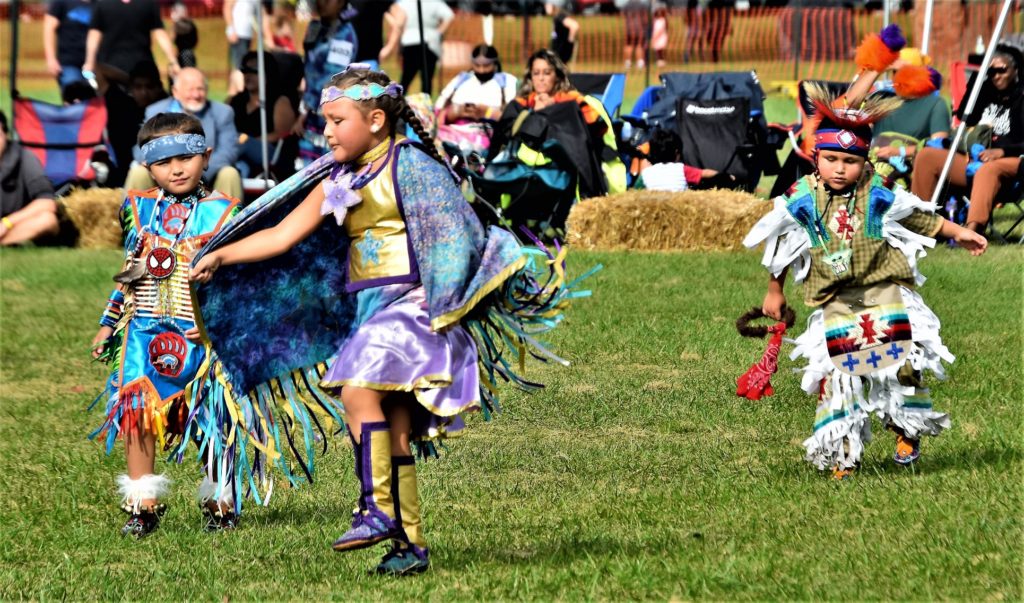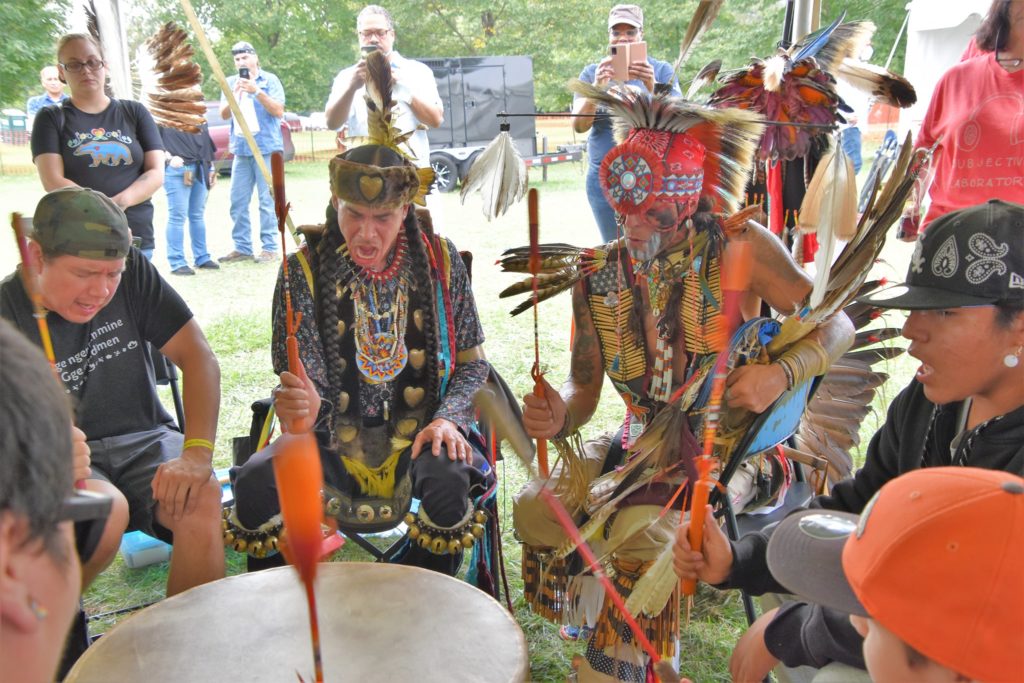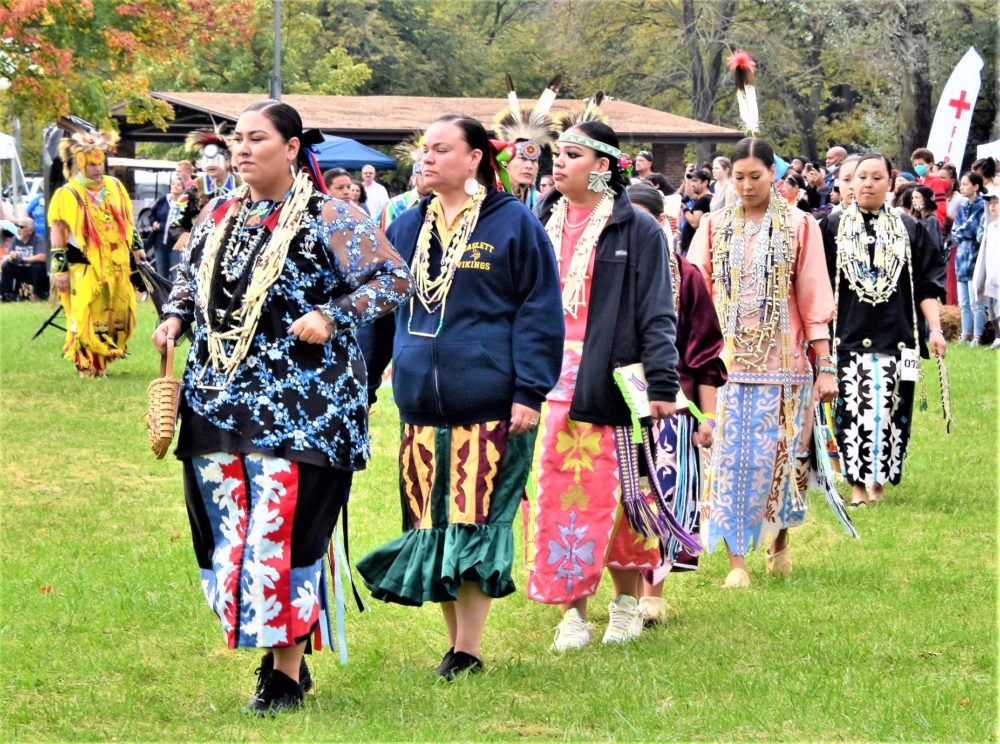Hundreds of people in the Chicago area gathered on the weekend of October 8 in the Schiller Woods Forest Preserve about an hour west of Chicago for the 68th Annual Chicago Powwow. The event was cancelled last year due to the COVID-19 pandemic, which has disproportionately affected Native communities across the country despite them having the highest vaccination rates of any ethnic group in the U.S.
At the event, emotions ran high as the attendees balanced the trauma of the pandemic with the joyous, festive occasion of being together and enjoying these traditions in person again. “I lost my cousin to COVID,” said Kiniw Cleland, twenty-two, who is from the Ojibwe and Odela tribes and currently lives in Canada. He was a vendor at the powwow.

“And he just lost his niece,” Cleland said as he pointed to an elder man sitting next to him. The man, who had long gray hair under a black baseball hat, and a gold watch with inlaid white and turquoise stones, quietly stared ahead as Cleland spoke.
An alarming number of people at the event mentioned having lost loved ones, echoing the harsh statistics reported throughout the pandemic. The CDC found that compared to white Americans, Natives in the US are 1.7 times more likely to test positive for coronavirus, 3.7 times more likely to be hospitalized, and 2.4 times more likely to die from the virus.
In the Midwest specifically, as recently as early October, Native populations saw a spike in weekly cases that was almost two-times that of any other ethnic group. Per 100,000 people, weekly cases were 292 for Natives, compared to sixty-nine for Asian, 119 for Black, 126 for Latinx, and 181 for white people.
“That’s why days like today are so important,” said RoxAnne LaVallie-Unabia , fifty-five, the executive director of the American Indian Health Service of Chicago (AIHSC).
“Whenever I see the jingle dress dancers I am always drawn to them for their healing aspect, and the history behind them. We’re hoping that through all of the powwows this summer we are able to come together and mourn those we’ve lost to COVID,” she said. “But also the healing through the dress and the dancing makes days like today so important to us.”
The powwow occupies a large, circular, grassy area about the size of a football stadium. The event is fenced off, so attendees must first visit the registration booth to pay a small fee and get a bright pink wristband. Once inside, people can visit a variety of arts and crafts vendors, food trucks, and other information booths under white farmers market-style tents that line the perimeter. In the center, the dancers perform to an audience sitting on a circle of lawn chairs.
The event is full of pride and community identity, which is both traditional and evolving. Several event attendees explained that most people prefer to be referred to as ‘Native’ or part of the ‘Native Community.’ ‘Indigenous’ was said to be fine, too, but nobody referred to themselves as such. Other terms like ‘American Indian’ and ‘Native American’ are on their way out.
President Biden’s recent announcement to recognize October 11, 2021 as the very first Indigenous People’s Day along with Columbus Day, reflects this change in vernacular. However, within many tribes, they refer to themselves as ‘The People’—or Diné for the Navajo, Anishinaabe for the Chippewa.
A free vaccination station near the powwow’s registration booth was a reminder of the high positivity and mortality rates among Natives and the importance of continuing to promote vaccinations. So far, Natives have the highest vaccination rates of any ethnic group in the US at fifty-eight percent, compared to forty-five percent of Asian Americans, forty-three percent of white Americans, thirty-seven percent of Black Americans, and forty-four percent of Latinx.
By mid-afternoon that Saturday, four people at the powwow had been vaccinated at the booth, and more were signing up.
However, there are multiple challenges that make it difficult to get vaccination rates to 100 percent, including generational trauma stemming from a long, searingly painful history of mistreatment by the U.S. government.
LaVallie-Unabia’s clinic offers free COVID testing and vaccines to members of the Native community. They have been a robust resource for the community during the pandemic, but one of their biggest challenges is getting the vaccination data they need from the City of Chicago. The City’s COVID data does not include “Native” or “Indigenous” as a category. It only has Black, white, Asian, Latinx, other, and unknown.
“One of the hardest parts for me wasn’t getting people to come in to be COVID tested, but to get the data collected from the City,” LaVallie-Unabia said. “We were originally told we weren’t a big enough population to be tracked. But recently, I have been working with the state to get things added into the system and they’ve been very receptive.” This data will help LaVallie-Unabia focus the clinic’s outreach efforts by tracking trends in vaccinations, infections, and deaths.
The AIHSC also tracks its own data. Anthony Anderson, Jr., who is twenty-seven and of Native, Black, and Latinx heritage, was hired during the pandemic to manage IT, but he also uses his degree in computer science to manage the clinic’s data. Anderson says the data confirms the higher positivity rates among the Native patients the clinic sees compared to non-Natives, even with the vaccine.
“It has a lot to do with their health,” Anderson said. “There are a lot of cheap, unhealthy American food in the Native community and overweight individuals, and that’s one of the main things that helps COVID kill you.”
Anderson also mentioned the high diabetes rates in Native populations. According to the CDC, Natives have a higher chance of having diabetes than any other US racial group. In a deadly intersection of public health issues, diabetes weakens the immune system, making it less able to fight off infections like COVID-19.
Another roadblock is vaccine hesitancy, rooted in mistrust of the government. Anderson’s grandfather, who he describes as “full blooded Native,” was taken as a child from his community in Indiana by the American government on the alleged grounds of domestic abuse, and brought to be educated in a government-run boarding school in Illinois.
The school, like many others created in the U.S. and Canada in the twentieth century, was intended to strip him of his Native identity and forcibly assimilate him to mainstream American culture. Anderson’s grandfather, who later fought in WWII, had been known to cry on at least one occasion when discussing his experience of losing connection to his heritage, Anderson said. He died recently at ninety-seven from old age.
From the 1960s to the 70s, the U.S. government also sterilized as many as twenty-five percent of childrearing-aged Native women. “People forget this,” LaVallie-Unabia said. “We always have to wonder what is in the vaccine and why it’s being pushed to the Native community first.”
However, LaVallie-Unabia and others at the event confirmed that most people they know did continue to move forward with getting vaccinated in the best interest of their community, especially with the Delta variant. “Within the Native community, we always pull together. At this point, the biggest thing we need is events like today.”
Most people at the powwow were there to forget about all of this. They are keenly aware of the past and present challenges and are quick to bring them up, a sign of how top-of-mind they are. More than anything, the event was a chance to get a moment of respite from the pandemic and to come together over their shared culture and unique, beloved dances.
As the afternoon carried on, dance groups continued to perform in what seemed like an infinite supply to the constant drumbeat of music pumping through large, concert-like speakers in the center of the event. Dancers who were either done or waiting their turn walked around the event like royalty in colorful feathers, bells, beaded jewelry, and ribbons. They, like the rest of the attendees primarily dressed in simple t-shirts and shorts, enjoyed frybread and explored the vendor booths.

The dancers were all ages, but many of them were children who will practice their cultural traditions for years to come. Carmine Day-Bedeau, fourteen, was one of them. He proudly stated that he is both named after a member of the Italian mafia, and that he is a member of the Oneida, Navajo, and Ojibwe tribes. It was a big day for him to share his dancing, which he trained for by running five miles a day, dancing fifteen or twenty songs a day, and playing basketball.
He showed a video on his phone of him dancing. His routine was spectacularly athletic, including cartwheels, splits, and constant movement—all while wearing a heavy, feathered regalia from head to toe.
After about thirty seconds, he paused the video, cleared away a Snapchat notification, and looked up with a smile and a sense of confidence behind his brown eyes. “It feels great to dance for other people. I dance for the people.”
Emily is a master’s student at the Medill School of Journalism. She’s in the Magazine Specialization, and is studying local news, as well as business and technology reporting. This is her first piece for the Weekly.




Love this piece! What a beautiful way of showcasing a resilient community and shedding light on an issue that is not talked about enough.